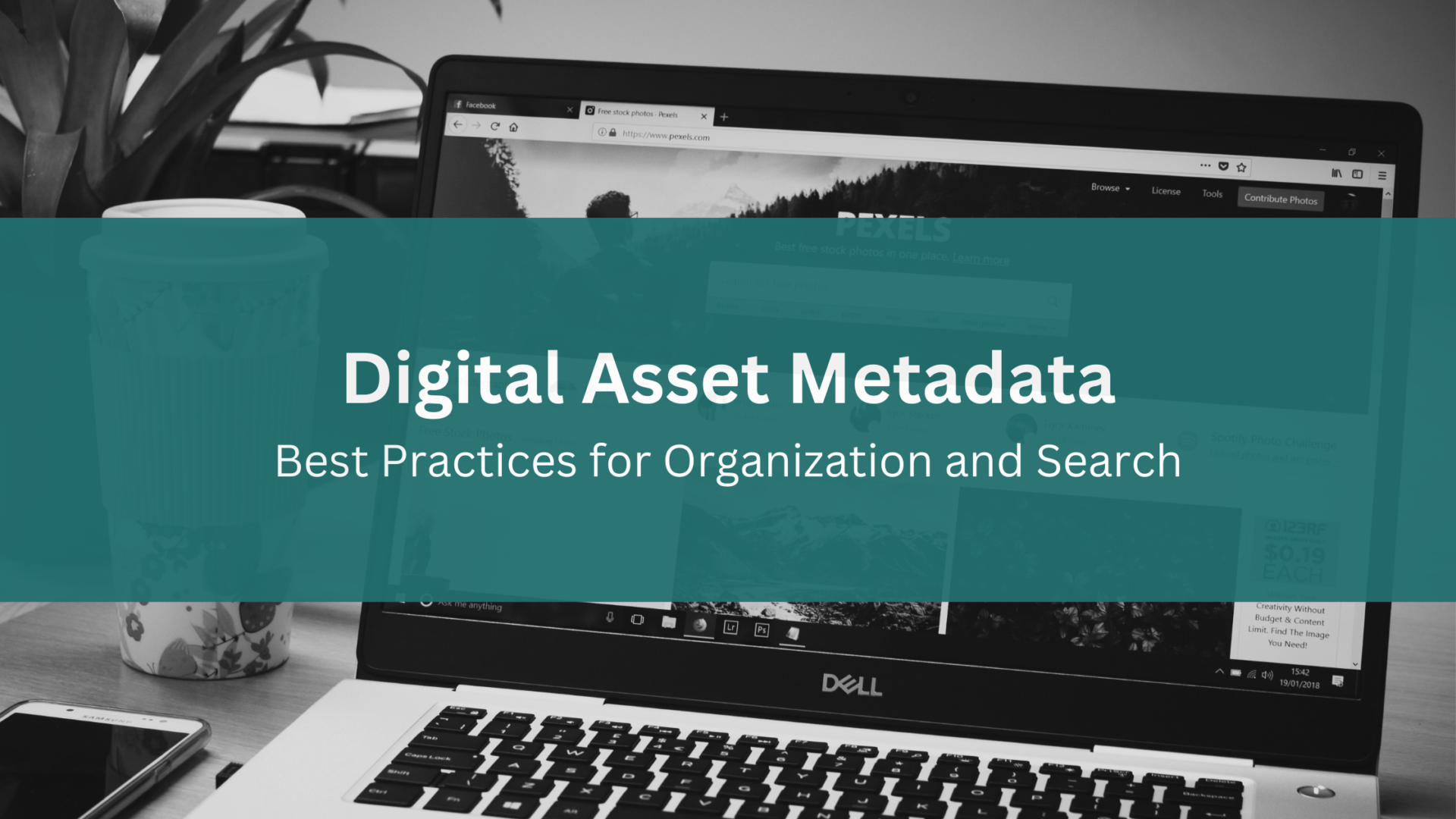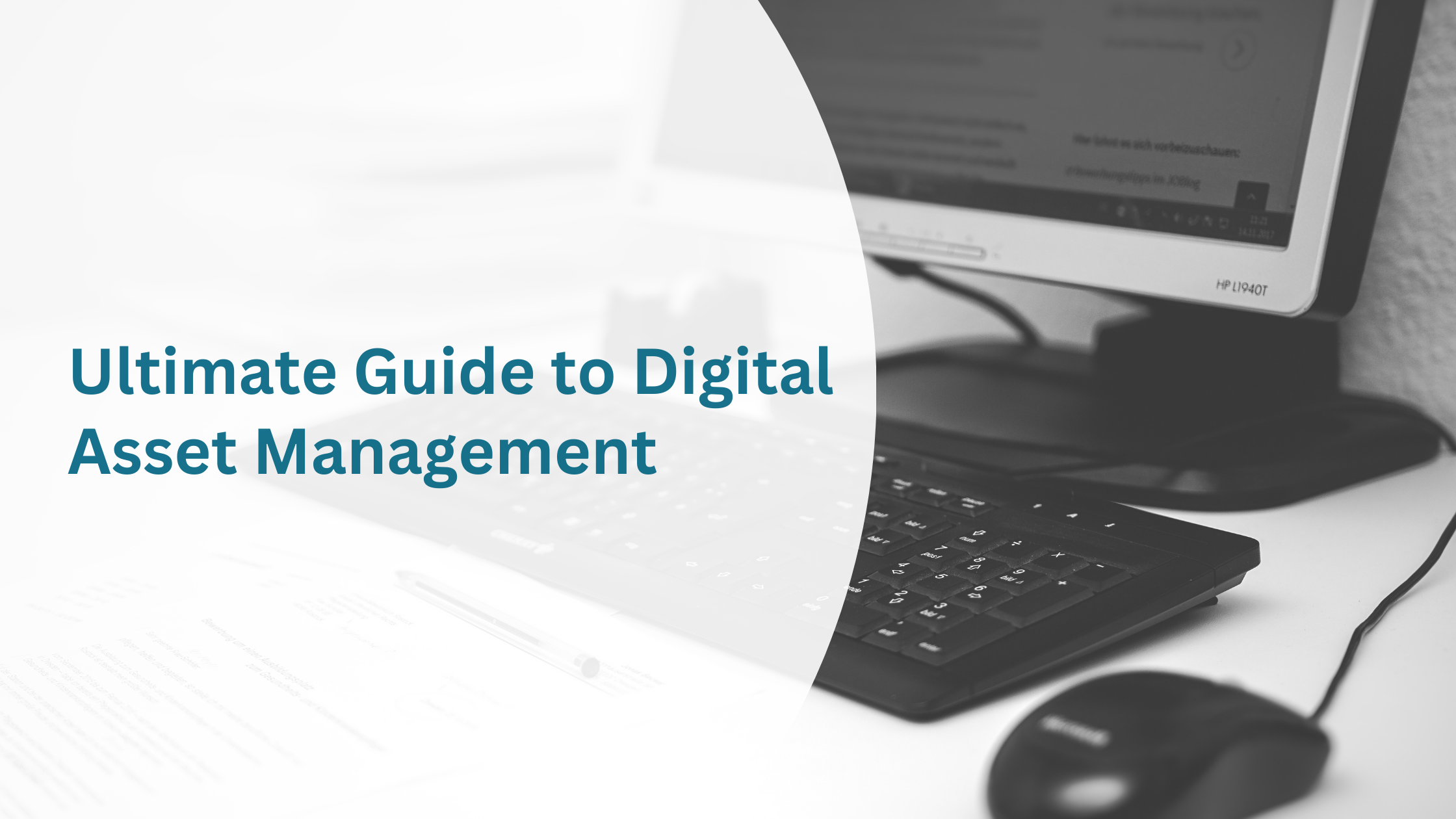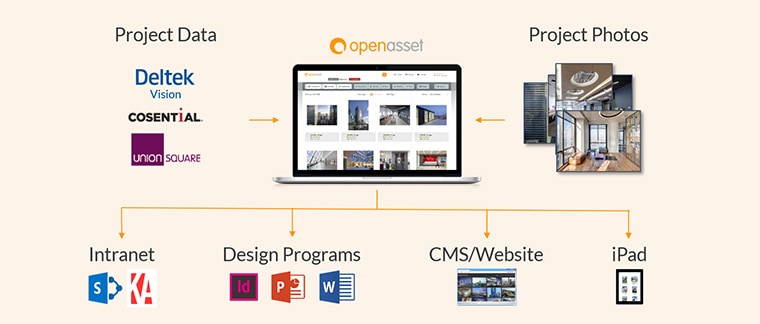Digital Asset Metadata: Best Practices for Organization and Search
Oct 26, 2023

We’ve all been there – desperately looking through countless digital assets, searching for just that one perfect file you need. The overwhelming feeling that comes with is something no one enjoys. But, how can we organize our digital assets better for quicker access? The answer? Knowing how to effectively use metadata in a Digital Asset Management (DAM) system.
If you aren’t too familiar with metadata, think of it as “data about data.” Seems simple. However, the challenge typically lies in using this metadata optimally to maximize the potential of your assets.
In this blog, we’ll explain the importance of metadata in DAM, provide metadata best practices, and share some tips on how to create effective metadata strategies using OpenAsset. By the end of this blog, you’ll grasp the significance of metadata in digital asset management and understand how to create effective metadata strategies that can elevate your user experience, enabling your DAM system to operate at its best efficiency.
What Is Metadata in DAM?
In the context of Digital Asset Management (DAM), “metadata” refers to the information that describes or classifies a digital asset. Simply put, metadata is “data about data” — in DAM.
Metadata is information about your digital assets. This information helps in the search, management, and efficient use of assets within the DAM system. Metadata can encompass a wide variety of details, depending on the nature of the asset and the needs of the organization.
It’s especially valuable for handling unstructured data, as it enables the establishment of standardized naming patterns and categories. This helps in recognizing and categorizing diverse content types, such as photographs, videos, and recordings. Such standardization ensures a well-organized structure within the digital asset management system.
The proper management and application of metadata within a DAM system is crucial. It ensures that assets are easily searchable, and categorized, and can be effectively utilized by various stakeholders.
What Are the Different Types of Metadata?
Various kinds of metadata exist. While basic metadata attributes include file name, file type, and size, it’s also possible to monitor and save numerous data elements for efficient digital content management. Here are the different types of metadata:
1. Descriptive Metadata
Descriptive metadata is information that describes the asset for search and discovery purposes. This might include title, description, keywords, and author.
Descriptive metadata allows you to save information regarding an asset’s content (for instance, items or entities in pictures, identified colors), its intended use (such as the purpose of its creation), and its historical background (like version numbers of the asset).
For example, let’s consider an architectural rendering or image of a modern office building as an example:
Descriptive metadata for such an image might include:
- ‘modern architecture’
- ‘glass facade’
- ‘office building’
- ‘sustainable design’
- ‘skyline’
- ‘multi-story’
- ‘commercial property’
2. Structural Metadata
Structural metadata indicates how complex objects are put together. It provides information about the formatting and setup of a digital file or asset, including aspects like page numbers, sections, chapters, and indexes, among others. Other commonly used fields within this category are:
- File name
- File type
- Dimensions or file size
- Description of content
- Keywords related to the content
- The person who uploaded it
- Designer or photographer (relevant for design files or photos)
- Date of creation
- Date of expiry
- Project or job identifier
3. Administrative Metadata
Administrative data provides information to help manage the asset. This can further be broken down into:
- Technical Metadata: Information about the technical aspects of the asset, such as file type, size, creation date, resolution, and compression techniques. This type of metadata is typically automatically generated when the image is created.
- Rights Metadata: Details about the intellectual property rights of the digital asset, including any licensing information, copyright status, or restrictions on use. The DAM administrator sets permissions based on the administrative metadata to specify which types of images users can view, edit, or download.
- Preservation Metadata: Information necessary for archiving and long-term preservation of the asset, such as its source, authenticity, and the means and methods of its preservation.
Metadata vs. Tags
The terms metadata and tags are frequently mentioned together, and at times, they’re used interchangeably, leading to uncertainty about their distinct meanings.
Here’s a brief overview:
Metadata
Metadata is a set of data that describes and gives information about other data. It provides structured, descriptive, administrative, and contextual information about a piece of content or a digital asset. Examples of metadata include file size, creation date, author, and resolution.
Tags
Tags are typically informal labels or keywords that are assigned to information (like articles, photos, or videos) to describe and categorize that information in a way that is meaningful to users. They are less structured than metadata and can be added to individual assets freely by users. They do not disturb the critical metadata that powers the DAM.
The Benefits of Metadata in DAM
In the world of digital asset management, metadata is important because it’s the data within your DAM system that makes digital assets searchable. Lacking this information, your DAM system simply wouldn’t function at its ideal level.
However, the benefits of metadata go well beyond organization and categorization. Metadata in DAM offers numerous benefits, ranging from improved search and discoverability to increased workflow productivity and team collaboration.
Here’s how metadata can enhance the worth of your digital assets and, in the end, benefit your business.
Better Organization
Metadata allows for assets to be grouped and classified into meaningful categories. Assets can be organized in a tiered manner, such as by project, type, date, or other relevant criteria. This level of organization ensures assets are reasonably and consistently stored, making it easier to browse and find related assets.
Additionally, this improves the user experience. For end-users, metadata enhances the browsing and search experience by allowing for more refined search options, better organization of results, and more detailed asset previews.
Enhances Searchability
One of the primary benefits of metadata is that it significantly improves the searchability of content. This, in turn, boosts the discoverability of assets. By describing assets in detail, users can locate specific items based on various attributes, not just the asset’s main content.
Metadata allows users to quickly and effectively find particular digital assets. Gone are the days of looking through countless folders for one asset. With files tagged using descriptive keywords and categories, users can conveniently go through various content to find the precise assets they require, saving both time and energy and streamlining workflows.
Promotes Collaboration
Metadata provides a common language for team members, ensuring everyone understands assets similarly.
Moreover, Metadata promotes teamwork by offering consistent and precise details about assets. With all team members accessing consistent metadata, everyone is aligned on aspects like an asset’s access permissions, version tracking, and other essential information. This alignment also helps avoid potential legal issues related to usage.
By standardizing how assets are described, metadata minimizes ambiguities and ensures that team members clearly understand each asset’s context, usage, and other details.
Boosts Efficiency
In large databases or repositories, managing digital assets becomes challenging. Metadata allows for quicker sorting, filtering, and organization, streamlining the asset management process. This can lead to a large increase in productivity and efficiency.
Metadata makes it easier for users to find the exact asset they’re looking for without searching through countless files. Users can also search based on specific metadata fields, refining their search criteria and finding assets more quickly.
Improves Accuracy
Metadata helps in maintaining the precision of asset details, decreasing the chances of mistakes and misunderstandings, particularly when AI is responsible for generating and tagging metadata. With clear metadata guidelines, there’s also a lower chance of mislabeling or misclassifying assets.
By offering aligned and consistent details, metadata safeguards the integrity of assets and guarantees that all team members use the appropriate file versions.
Robust Preservation
Preservation metadata ensures that assets remain accessible and understandable in the long term by detailing the means and methods of their protection. Without a system that safeguards metadata, organizations create inconsistent and typically incorrect metadata.
Provides Detailed Analytics and Reporting
Organizations currently produce vast amounts of data through the diverse tools and technologies they utilize daily. Metadata allows organizations to generate insights about the use, popularity, and relevance of their assets, helping in decision-making processes.
Metadata Best Practices for Organization and Search
Now that we understand the importance of metadata in DAM and its benefits, let’s take a look at best practices. Understanding how metadata in DAM offers various benefits for effectively managing digital assets in organizations. Looking at the best practices will ensure you maximize the potential of your DAM’s metadata.
Here are metadata best practices to follow:
Define Your Taxonomy and Schema
Setting up a well-defined and thorough taxonomy is crucial to label and classify digital assets. Taxonomy is the hierarchical classification of your data. Before diving into metadata, it’s important to understand and define the categories and subcategories that best represent the digital assets in your organization.
By developing a taxonomy customized to your organization’s requirements, you offer a consistent structure for labeling and categorization, guaranteeing uniformity and streamlined searching.
When developing your metadata taxonomy:
- Start Broad, then Narrow Down: Begin with general categories and then drill down into more specific ones. For example, “Architectural Styles” can be a broad category, with subcategories like “Gothic,” “Modernist,” and “Baroque.
- Involve Stakeholders: Engage different departments or teams to ensure the taxonomy aligns with their needs and terminologies.
The structure of your metadata is known as the metadata schema. Therefore, your schema will define the structure and type of metadata you’ll use. It’s the blueprint for how metadata will be captured, what fields will be used, and how they relate to one another.
Keep your metadata schema clear and concise. Your metadata schema should follow these guidelines:
- Consistent Fields: Establish clear guidelines on the type of metadata fields you’ll use, such as text, date, number, etc.
- Use of Controlled Vocabularies: Ensure that specific fields use a controlled vocabulary or a predefined list to maintain consistency.
- Add value: Consider if the metadata will add value to DAM users
Additionally, The metadata fields required by your organization will vary based on your industry, but the typical ones are:
- Asset name or title
- Product or part numbers
- Asset creator, author, or owner
- ‘Action dates’ (‘Date created’ and ‘Expiry date’).
- Asset type
- The asset’s ‘subject’, e.g. family, vehicle, building, etc.
Regularly Update and Optimize Metadata
Your DAM’s metadata framework shouldn’t be a one-time setup. It’s essential to regularly update and optimize the metadata within the DAM system to guarantee its continued relevance and precision.
As the system progresses and expands, your metadata should adapt accordingly. It’s vital to consistently evaluate and enhance the metadata, discarding fields that aren’t proving beneficial and incorporating new ones as needs emerge or are identified by the team.
Maintain a Simple Metadata Schema
A complex metadata schema can be overwhelming, leading to inconsistent tagging and difficulty in asset retrieval. A DAM system is designed to simplify tasks for your team. Particularly in enterprise metadata management, where assets and their associated metadata can grow rapidly, having a streamlined system is essential for efficiency.
Start by focusing on the most critical fields that offer the most value in terms of searchability and organization. Avoid including every possible detail. Moreover, Incorporate only a select number of fields, ensuring that only the most crucial ones are set as required.
Additionally, design the metadata schema with the end-user in mind. Think about what they would most likely search for or how they would categorize assets. You should also ensure that there aren’t multiple fields capturing the same or very similar information. This reduces confusion and ensures a more streamlined tagging process.
Automating this metadata labeling process can significantly reduce time spent while guaranteeing that all crucial metadata is appropriately captured.
Create Clear Naming Conventions
Creating a clear naming convention for each metadata field is another important factor to consider when working with metadata.
Setting up uniform naming conventions for digital assets leads to clear and consistent identification. Formulate naming standards that incorporate complex details, like the date, project title, or kind of asset.
Think about adopting a consistent format that’s intuitive and straightforward to implement. For example, a file name for an architecture project image could look like: “Date_ProjectTitle_AssetCreator.jpg” or any other combination that works for your organization.
Inform and relay the naming guidelines to all team members involved with digital assets. Offering clear instructions and ensuring compliance will enhance the overall efficiency of asset categorization and access. Follow these tips when creating naming conventions:
- Steer clear of special characters like (! ? @ # $, and so on) since they can be ambiguous when searching and may occasionally carry specific functions in the operating system.
- Consider how filenames might be perceived by individuals outside your organization, as they can occasionally appear in embed codes or shared links.
By maintaining an aligned naming system, assets are more readily identifiable, manageable, and searchable.
Remember to inform and communicate the naming guidelines to all team members involved with digital assets. Offering clear instructions and ensuring compliance will enhance the overall efficiency of asset categorization and access.
Provide Metadata training
Regularly train team members on the importance of metadata and best practices. As your DAM evolves or new members join, they should be familiar with the system’s requirements. It’s crucial to educate all users about the significance of metadata and the correct methods for inputting it into the DAM system. This guarantees uniformity and accuracy in metadata entries.
After all, the effectiveness of your DAM implementation and user adoption relies on proper training, especially when it comes to ensuring users understand the correct application of metadata.
To succeed, engage the entire team in crafting your metadata framework to greatly enhance the accuracy of digital asset categorization. Moreover, having a well-defined metadata guidelines document is crucial for a seamless transition if there’s a new DAM administrator.
Leverage AI
Leveraging the power of AI in DAM and the auto-tagging features in a DAM system can greatly simplify and streamline the process of adding metadata to your content.
Using AI for auto-tagging eliminates the manual labor of entering metadata, saving a significant amount of time, especially when dealing with large volumes of assets. Moreover, while AI can handle the bulk of tagging, users can still manually adjust or add tags as needed, combining the best of automation and human judgment.
By embracing these best practices for metadata in DAM, your organization can proficiently integrate metadata into your DAM system, unlocking its maximum capabilities like enhanced search functions, heightened efficiency, and improved digital asset management.
Tips on How to Create Effective Metadata Strategies Using OpenAsset
Creating effective metadata strategies using a platform like OpenAsset requires a combination of understanding the system’s capabilities, best practices for metadata management, and the specific needs of your industry or organization.
Similar to the best practices listed above, here are some quick tips to help you create effective metadata strategies using OpenAsset:
Understand Your Assets:
- Begin by conducting an audit of the types of digital assets you have.
- Group them into broad categories (e.g., images, documents, videos).
Develop a Metadata Taxonomy:
- Based on the assets you’ve identified, create a taxonomy that clearly defines categories and subcategories.
- Ensure that this taxonomy aligns with the terms and language commonly used within your organization or industry.
Standardize Naming Conventions:
- Establish consistent naming rules that are intuitive.
- Incorporate relevant details, such as date, project name, asset type, etc.
Utilize OpenAsset’s AI and Auto-Tagging Features:
- Use the platform’s automated tools to assist in tagging your assets.
- This ensures that even if a manual entry is missed, the asset still gets basic tags.
Train Your Team:
- Educate everyone involved in uploading and using assets on the importance of metadata.
- Encourage them to consistently apply the correct tags and names based on the conventions and taxonomy you’ve established.
Review and Refine Periodically:
- Regularly check the effectiveness of your metadata strategy.
- Modify and adjust based on the changing needs of your organization or any feedback from users.
Leverage OpenAsset’s Search and Filter Capabilities:
- Ensure that you’re making the most of OpenAsset’s advanced search features.
- Tailor and customize search filters based on the metadata you’ve implemented.
Maintain a Simple Metadata Schema:
- Don’t overcomplicate. A straightforward and intuitive metadata schema ensures easy adoption and adherence by all users.
Implement User Feedback:
- Actively seek feedback from users regarding metadata effectiveness.
- Incorporate suggestions to ensure the metadata strategy remains relevant and efficient.
Stay Updated with OpenAsset’s Features:
- As the OpenAsset’s platform evolves, we introduce new features or tools that can help enhance your metadata strategy.
- Regularly check for updates and adapt your strategy accordingly.
Next Steps
As we’ve explored throughout this guide, metadata isn’t just “data about data”—it’s the foundation for streamlining workflows, ensuring consistent collaboration, and driving productivity.
Implementing robust metadata strategies, like the ones highlighted in our best practices and tips, is more than a technical task. It’s about building an environment where assets are at everyone’s fingertips, where team collaboration becomes seamless, and where every digital resource is used to its maximum potential.
AEC firms have a continuously growing library of assets. The escalating demand for high-quality assets, coupled with the ease of acquiring them, can result in significant workflow bottlenecks. If your firm is finding it challenging to handle an expanding collection of project photographs and graphics, it may be time to explore a DAM solution.
If you’re serious about leveraging the full power of your digital assets, now is the time to do so with a DAM like OpenAsset. As AEC professionals, you have unique needs and challenges, and OpenAsset is tailored to meet those demands head-on. OpenAsset makes AEC proposals simpler, faster, and more successful. That’s why 99% of customers renew.
By integrating these metadata best practices, you’re not only investing in better asset management but you’re ensuring a more organized, efficient, and productive future for your firm. This results in an increased ROI for your organization.
Don’t let your assets become just another file lost in the digital abyss. Take the next step and get in touch with OpenAsset to transform how your organization manages, retrieves, and leverages its invaluable digital resources.





